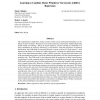Free Online Productivity Tools
i2Speak
i2Symbol
i2OCR
iTex2Img
iWeb2Print
iWeb2Shot
i2Type
iPdf2Split
iPdf2Merge
i2Bopomofo
i2Arabic
i2Style
i2Image
i2PDF
iLatex2Rtf
Sci2ools
JMLR
2008
2008
Learning to Combine Motor Primitives Via Greedy Additive Regression
The computational complexities arising in motor control can be ameliorated through the use of a library of motor synergies. We present a new model, referred to as the Greedy Additive Regression (GAR) model, for learning a library of torque sequences, and for learning the coefficients of a linear combination of sequences minimizing a cost function. From the perspective of numerical optimization, the GAR model is interesting because it creates a library of "local features"--each sequence in the library is a solution to a single training task--and learns to combine these sequences using a local optimization procedure, namely, additive regression. We speculate that learners with local representational primitives and local optimization procedures will show good performance on nonlinear tasks. The GAR model is also interesting from the perspective of motor control because it outperforms several competing models. Results using a simulated two-joint arm suggest that the GAR model co...
GAR Model | JMLR 2008 | Library | Motor Control |
| Added | 13 Dec 2010 |
| Updated | 13 Dec 2010 |
| Type | Journal |
| Year | 2008 |
| Where | JMLR |
| Authors | Manu Chhabra, Robert A. Jacobs |
Comments (0)

